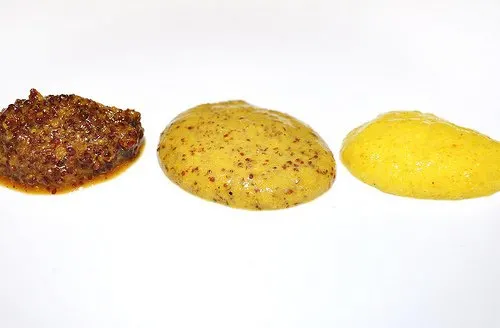It’s probably safe to assume that everyone has a jar or bottle of dijon mustard somewhere in their kitchen. Whether it’s in the fridge, leftover from the family barbecue over the summer, or that mysterious unopened bottle in the back of your pantry, you may be asking yourself, “can dijon mustard go bad?” How should you store this condiment, and what exactly is the shelf life of dijon mustard?
Can Dijon Mustard Go Bad?
Surprisingly, dijon mustard actually can go bad. While many of the ingredients in dijon mustard are natural preservatives, the condiment will degrade in quality over time. Typically, the shelf life of unopened dijon mustard is around two to three years past the printed expiration date on the label. After that point, the mustard will begin to decline in quality. While the jar or bottle of mustard should still be safe to consume (so long as it has not been opened) it might not taste as good!
Opened mustard has a shorter shelf life, and can last in your refrigerator for up to two years, if tightly sealed and kept away from moisture and contaminants. After this point, the quality will begin to decline, and repeated use could lead to contamination. Always check the mustard for signs of spoilage before using it!
Image used under Creative Commons from jeffreyw
Homemade mustard does not have as long a shelf life as commercially produced and bottled brands. If you’ve made homemade mustard, and it is tightly sealed, it could last for anywhere between a few weeks to six months in the refrigerator, depending on the recipe. Because of the variation in potential shelf life, you should always check for signs of spoilage before consuming homemade mustards.
Signs Dijon Mustard Has Gone Bad
While dijon mustard will typically not spoil in the traditional sense, it can still go bad. After a period of time, mustard will begin to dry out, and become much darker in color. At this point, the mustard should not be consumed. Similarly, mustard will separate over time. While this may not necessarily indicate a safety hazard, it is an indication that the mustard has begun to spoil.
Moisture that accumulates in the bottle can lead to mold and bacteria growth. For this reason, you should always make sure to tightly seal jars or bottles of mustard. Any sign of mold growth indicates spoilage, and the mustard should not be consumed.
If the mustard has an off smell, or the bottle has swelled, there could be some unwanted bacterial growth. These are sure signs that the mustard has gone bad, and should not be consumed. Similarly, if there seems to be pressure in the bottle, or it makes a popping noise when opened, the mustard has spoiled and should be discarded. Tightly sealing the container, and using clean utensils when serving mustard will help to eliminate these issues.
How to Store Dijon Mustard
Unopened containers of dijon mustard can be stored in your pantry, or in another cool, dark place. Be sure the container is kept away from heat and moisture.
Once opened, jars or bottles of mustard should be refrigerated to ensure the safety and quality of the condiment. While mustard can be stored in the freezer, it’s likely that the mustard will separate, and may not mix back together completely. Additionally, freezing mustard will not extend its shelf life beyond the year that it can last in the refrigerator, so there is little benefit to freezing mustard.
If you’ve made homemade mustard, canning is a good option for preservation. Depending on the acid content of your mustard, most recipes can be processed using a water bath. If you follow proper sanitation and canning methods, the resulting sealed jars of dijon mustard should remain shelf stable for up to a year. Be sure to store jars of mustard away from moisture, light or heat for best results.
